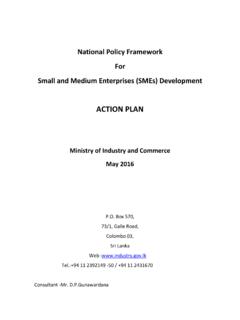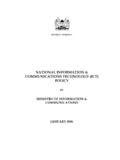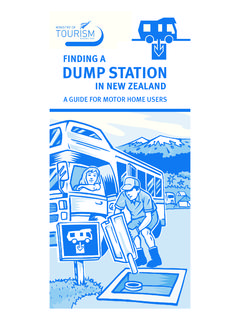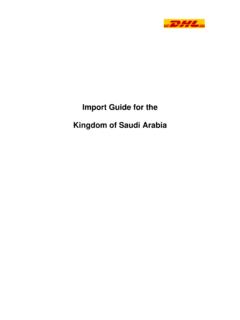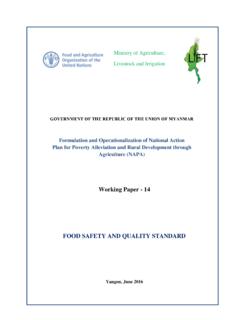Transcription of Table of Contents - Ministry of Industry and Commerce
1 Table of Contents Page 1. Introduction .. 1. 2. Vision, Mission and Objectives of the SME Policy Framework .. 1-2. 3. Definition of SMEs .. 3. 4. High Potential Promising Clusters 4. 5. Policy Interventions and Strategies . 5. a. Enabling Environment 5. b. Modern Appropriate Technology 6. c. Entrepreneurial Culture and Skills Development .. 7. d. Access to Finance .. 8. e. Market Facilitation .. 8. f. Research and Development .. 9. g. Resource Efficiency .. 10. h. Regional Balance .. 11. 6. Implementation Arrangements . 11. a. Coordination for the Implementation of the Policy 11. b. SME Advisory Council .. 12. c. SME Cluster Committees 12. d. Monitoring and Evaluation .. 13. 7. Conclusion .. 13. Tables Table I: Defining SME in Sri Lanka .. 3. Figures Figure 1: SME Policy Framework Matrix .. 3. National Policy Framework for Small Medium Enterprise (SME) Development 1. Introduction The Small Medium Enterprise (SME) sector has been identified as an important strategic sector in the overall policy objectives of the Government of Sri Lanka (GOSL) and it is seen as a driver of change for inclusive economic growth, regional development, employment generation and poverty reduction.
2 SME sector is envisaged to contribute to transform lagging regions into emerging regions of prosperity. The Government of Sri Lanka recognizes SMEs as the backbone of the economy, as it accounts for more than 75% of the total number of enterprises, provides 45% of the employment and contributes to 52% of the Gross Domestic Production (GDP).SMEs promote broad based equitable development and provide more opportunity for Women and Youth participation in the economic development of the country. With the globalization trend, the SME sector is not merely seen as a sector for protection and promotion but, more importantly as driving force for growth and development . Therefore, Government of Sri Lanka recognizes that enhancing national and international competitiveness is fundamentally important for this sector to face the emerging challenges and develop SMEs as a thriving sector. Given the nature of this sector and the challenges faced, it is important to have a Government led intervention and support mechanism to upgrade and strengthen this sector to meet the expectations of the country.
3 This SME Policy Framework aims to promote high potential, promising SMEs and improve business environment to allow them to realize their full potentials in today's globalized economy. This Policy Framework will foster small enterprises to grow into medium sized enterprises and medium sized enterprises to grow into large enterprises and large enterprises to grow into globally competitive enterprises. 2. Vision, Mission and Objectives of the SME Policy Framework Policy Vision The vision of the National SME Policy Framework is to create significant number of globally competitive, dynamic, innovative, technologically driven, eco-friendly and sustainable SMEs that contribute greatly to the national economic development. Policy Mission The mission of the National SME Policy Framework to stimulate growth of SMEs to produce world class products& services that can compete locally and internationally with supportive enabling environment and interventions of technology transfer, entrepreneur culture, skills development, access to finance, market facilitation and research and development.
4 National Policy Framework for SME Development Page 1. Policy Objectives The SME Policy Framework will support start-up SME enterprises, strengthen the existing enterprises and extend nursing programmes for potentially viable sick SMEs. SME policy will focus on the following aspects. Promoting high potential, viable and promising sectors Focus on cluster approach for SME Development. Under the cluster approach, the entire value chain from input supply to processing and export will be supported and promoted. Promote enterprises with high value addition and encourage enterprises that use the local raw materials as they offer strong comparative advantages due to factor endowments. Motivate and encourage export oriented or import substitution enterprises and industries. Encourage and promote flagship SME sectors with high potential spillover effects to facilitate job creation or employment generation. Promotion and relocation of industries in the backward regions to reduce urban-rural imbalances.
5 Transforming the landscape of the SMEs away from mere trade and Commerce towards production and Industry based with special focus on high value addition, innovative and usage of modern appropriate technology. Strengthening the SME sector in order to enhance inclusive economic development and thus provide opportunities for better employment and higher income. Achieve regionally balanced growth across Sri Lanka. Promote resource efficiency at all levels including the use of Green Technology The SME Policy framework will also give special attention to maintain nature's capital, green growth, entrepreneurship development, women entrepreneurship, craft sector and promising industrial clusters by strengthening enterprise villages, handicraft villages, Industrial production villages and SME industrial estates / zones. National Policy Framework for SME Development Page 2. Figure1: SME Policy Framework Matrix 3. Definition of SMEs The term SME is used to denote micro, small and medium enterprises.
6 Different countries use different definitions for SMEs based on their level of development. The commonly used yardsticks are total number of employees, annual turnover and total investment. In the Sri Lankan context, the SME policy framework defines SMEs based on the number of employees and annual turnover. National Policy Framework for SME Development Page 3. Table 1: Defining SMEs in Sri Lanka Size Criteria Medium Small Micro Sector Manufacturing Annual Turnover Rs. Mn. 251 - 750 Rs. Mn. 16 - 250 Less than Rs. Mn. Sector 15. No. of Employees 51 - 300 11 - 50 Less than 10. Service Sector Annual Turnover Rs. Mn. 251 - 750 Rs. Mn. 16 - 250 Less than Rs. Mn. 15. No. of Employees 51 - 200 11 - 50 Less than 10. The category of Small and Medium sized Enterprises (SMEs) is made up of a enterprises which employ less than 300 employees and which have an annual turnover not exceeding Mn. In this context, micro enterprises are also read with SMEs for any policy related measures.
7 In terms of definition, both criteria are considered in defining SMEs. In the event of an enterprise falling under more than one category then the level of employment should be the deciding factor. The ceiling applies to individual enterprises only. Subsidiaries of holding companies shall not be considered as SMEs. However in the event of turnover and number of employees of whole group is within the above limits this exclusion will not arise. The purpose of SME definition is to provide an instrument for the targeting of policy, provision of national statistics on SMEs, serves as basis for directing State support for SMEs and targeting a broader range of policy measures. This definition be revisited once in 3 years and amended where necessary based on the economic and business development in the country. 4. High Potential Promising Clusters For the purpose of supporting and encouraging SMEs, the high potential promising clusters have been identified.
8 In determining the promising clusters; criteria such as the value addition, use of local raw materials, export orientation / export connectedness, forward and backward linkages, and flagship sectors with high spillover effects, technologically driven innovative products and employment generation aspects are considered. The Government in supporting enterprises will give preference for the committed, capable and interested entrepreneurs with reasonably good track record. In this regard, the policy of Picking the Winner will be adopted in giving preference for supporting entrepreneurs. This policy of picking the winners will give due consideration to the following criteria National Policy Framework for SME Development Page 4. (a) proven credentials as an entrepreneur (b) reasonable and fair amount of equity participation (c) skills and competencies acquired in the relevant sector or cluster (d) ability to meet and comply with the recognized quality assurance processes (f) commitment to innovation and (g) women entrepreneurs.
9 5. Policy Interventions and Strategies This SME Policy Framework will broadly set out the policy direction, the challenges to be addressed and the broad intervention strategies. The major policy intervention areas are identified into six core areas namely enabling environment, modern appropriate technology, entrepreneurial culture and skills development, access to finance, market facilitation and research and development. Also it is important to focus on the regional balance and resource efficiency in developing SMEs. Enabling Environment: Policy Perspective: The Government of Sri Lanka will improve the legislative, regulatory and institutional framework including proper coordination, simplification and rationalization of procedures to enhance the ease of doing business to improve the competitiveness and support in establishing a conducive environment for SME development. Challenges Addressed: Reduce transaction cost and improve ease of doing business for SMEs Key Strategies: - Design and enforce SME friendly laws and regulations and contract enforcement to strengthen the legal environment for SMEs - Improve the quality and outreach of service delivery of SME related Ministries, Departments, Statutory Boards, and other public and private sector institutions.
10 SME. friendly front office or SME desk in key ministries / agencies and one-stop service should be provided to SMEs through a coordinated approach. - Support and improve infrastructure facilities including common service centers, industrial estates, incubation facilities and geographical location based clustering and SME enterprise village development mainly focus on less developed regions. - Strengthen public private dialogue and partnership arrangements and development of industrial associations for more effective empowerment and involvement. - Simplification of business and Industry commencement and dispute settlement procedures including simplification of accounting standards. National Policy Framework for SME Development Page 5. - Create awareness to SMEs on green growth opportunities and promote environmental friendly cleaner production technologies and practices. Modern Appropriate Technology Policy Perspective: The Government will facilitate the acquisition and adoption of state- of-the-art modern and appropriate clean technologies for SMEs to increase quality, innovative, productive and competitive products.
